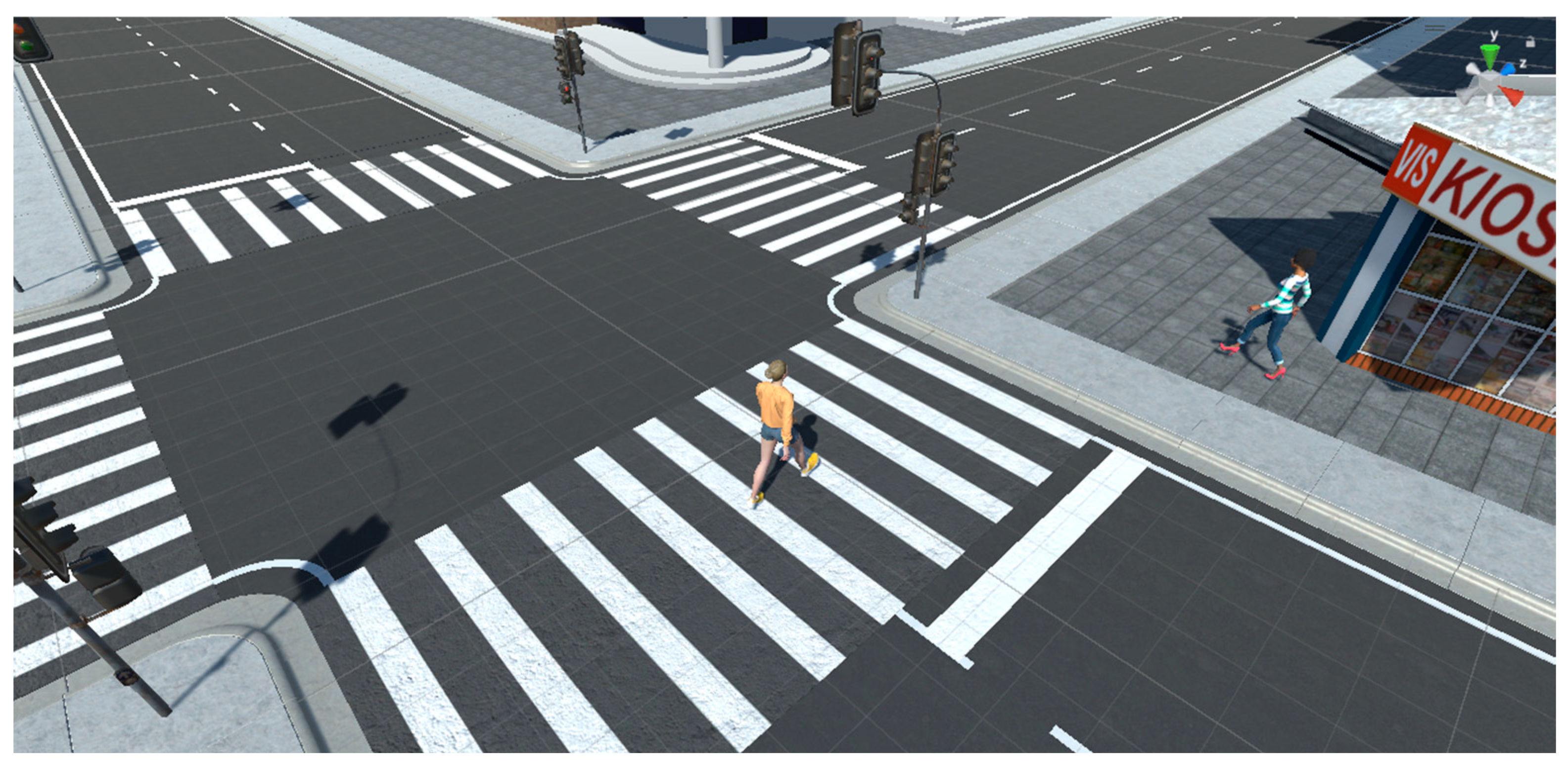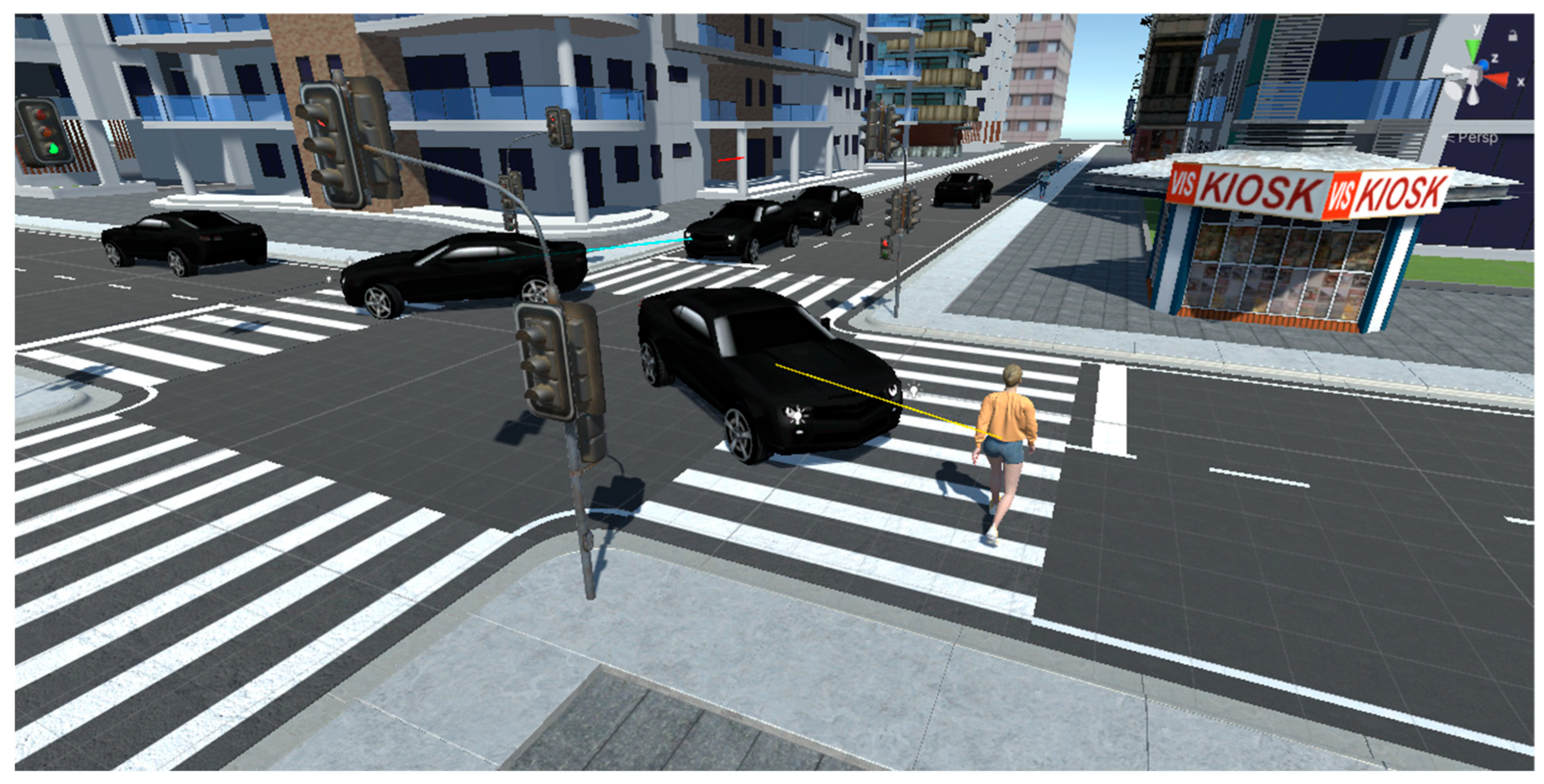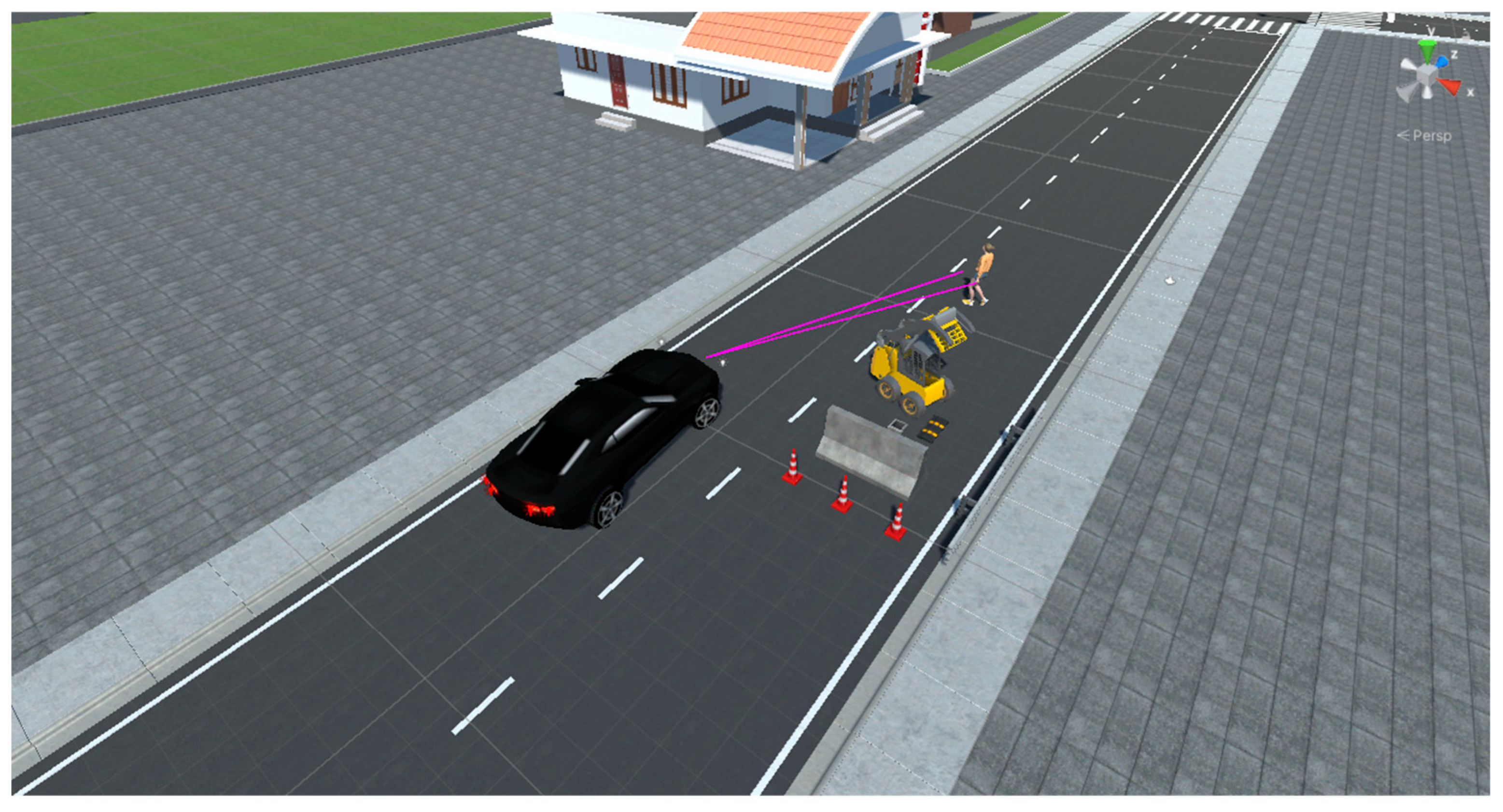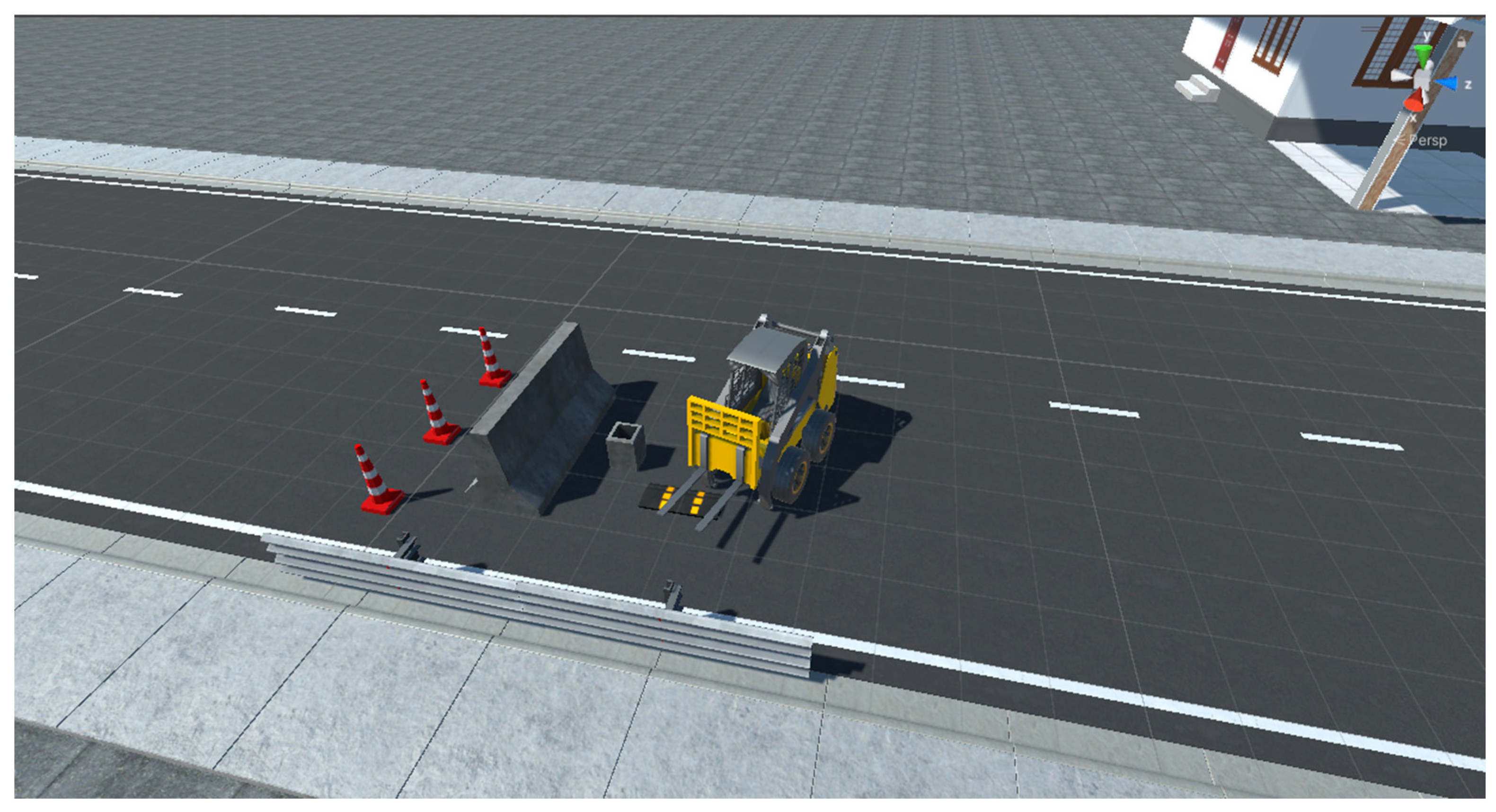Simulator of Safe Interaction Between Driver, Pedestrian, Car, Road and Environment †
Abstract
1. Introduction
2. Theoretical Foundations
- Driver. The activity of a motor vehicle operator is related to controlling a moving object—a car. The driver constantly observes a certain part of the space, from which they receive information about the road situation. They process and evaluate this information, make decisions about actions in specific situations, and perform the corresponding actions—steering, shifting gears, pressing the gas and brake pedals, turning lights on and off, periodically monitoring instrument readings, etc. Therefore, when driving a car, the driver must perform three main functions:
- Detect and recognize events or objects on the road;
- Make decisions;
- Perform a series of actions to control the vehicle.
- Pedestrian. Pedestrians on the road often make unexpected decisions that can lead to risky situations. It is important to observe their behavior when crossing pedestrian crossings and interacting with moving vehicles.
- Vehicle. Vehicles on the road can be both traditional cars and autonomous vehicles equipped with various safety technologies (sensors, cameras, automatic braking, and maneuvering systems). The behavior of vehicles can be modeled in simulations, including interactions with other traffic participants.
- Road. Road infrastructure includes roads, pedestrian crossings, traffic lights, road signs, and other elements. Changes in road conditions (repairs, traffic jams, poor road conditions) can affect safety and require adaptation from drivers and pedestrians.
- Environment. The environment is an important factor for road safety. Meteorological conditions such as rain, snow, fog, or glare can reduce visibility and traction, increasing the risk of accidents.
3. Simulator Methodology
Main Components of the Simulator
- Driver Model: This model includes a driver interface that can control the vehicle, making decisions about speed, braking, maneuvering, and reacting to pedestrians and other traffic participants. The model can be used for both traditional drivers and autonomous vehicles.
- Pedestrian Model: The pedestrian’s task is to safely cross roads using pedestrian crossings and traffic lights. Pedestrians are placed in various scenarios, including crossing the street during heavy traffic or in conditions of limited visibility.
- Vehicle Model: The simulator can include both traditional vehicles and autonomous vehicles. Autonomous vehicles are equipped with safety technologies such as pedestrian detection sensors and automatic braking in case of obstacles.
- Road Infrastructure: Roads, pedestrian crossings, traffic lights, and road signs are part of the simulation. It includes various conditions such as roadworks, traffic jams, and changes in road conditions.
- Meteorological Conditions: The simulation can include various weather scenarios such as rain, snow, fog, and sunlight, which affect visibility and vehicle traction.
4. Simulation Tools and Technologies
5. Results and Applications of the Simulator
5.1. Key Aspects of the Simulation
- Simulation of Pedestrian Behavior. Pedestrians in the simulation can have different behaviors, from a pedestrian who carefully crosses the pedestrian crossing to a pedestrian who may cross without looking at oncoming vehicles. Simulating these differences in behavior can provide important lessons for safety.
- Interaction with Vehicles. The simulation can observe how vehicles react to the presence of a pedestrian at a pedestrian crossing. This includes whether the driver stops in time, how autonomous vehicles react, and how traffic is affected by the interaction between drivers and pedestrians.
- Changing Conditions. Simulations can include various changing conditions such as day/night, rain, snow, fog, or snow cover to see how these factors affect visibility and pedestrian safety at crossings.
- Driver Reactions. The simulation can include driver behavior, such as reactions to new technologies like intelligent transportation systems or autonomous vehicles trained to recognize pedestrians and stop when in danger.
- Scenario Analysis. Development of various scenarios, including pedestrians with disabilities (e.g., elderly people or people with disabilities), to ensure accessibility and safety when crossing pedestrian crossings.
5.2. Testing Different Scenarios
- Scenario 1: Pedestrian at a Pedestrian Crossing. In this scenario, a pedestrian must cross a street, and the driver must stop to ensure safe passage.
- Scenario 2: Road Conditions with Limited Visibility. This scenario simulates conditions with fog or rain, where both the driver and pedestrian must adapt to reduced visibility and traction.
- Scenario 3: Autonomous Vehicles in Complex Conditions. In this scenario, autonomous vehicles must interact with other vehicles and pedestrians while adhering to safety rules.
- Scenario 4: Road Repairs and Unexpected Obstacles. This scenario creates conditions of road repairs that pose safety risks, requiring the driver and pedestrian to react appropriately.
5.3. Goals of Pedestrian Crossing Simulation
- Behavior Prediction. Simulations can recreate pedestrian behavior in various situations (e.g., when a pedestrian is at a crossing and needs to cross, or when there is heavy traffic). This allows for risk analysis and the prediction of potential accidents (Figure 2).
- Evaluation of Road Infrastructure. Through simulations, the characteristics of pedestrian crossings can be tested and optimized, from their design (width, visibility) to signaling (pedestrian lights, warning signs, etc.). This allows for the analysis of various scenarios and the proposal of solutions to improve safety.
- A pedestrian suddenly crossing the road.
- Other vehicles making unexpected maneuvers or not stopping at pedestrian crossings.
- Exiting traffic, where the autonomous vehicle must find a safe route.
- Bad weather (snow, rain) that reduces visibility or road traction.
- Changed Road Markings: Autonomous vehicles rely on clear road markings to navigate traffic. The removal of markings or changes in road signs during repairs can create difficulties for object recognition systems.
- Narrow Roads and Uneven Surfaces: Repaired sections often lead to narrow lanes and uneven surfaces, which place additional strain on vehicle control systems (Figure 4).
- Traffic Changes: When detours are introduced, the autonomous vehicle must quickly analyze the new situation, determine the safest route, and respond to dynamic conditions.
5.4. Results
6. Conclusions
- Training Drivers and Pedestrians: The simulation offers practical training opportunities, allowing participants to learn how to react in various scenarios without risking safety.
- Testing Autonomous Technologies: The simulator can be used to test autonomous vehicles that must interact with their environment, including pedestrians and other vehicles.
- Improving Road Infrastructure: Through simulations, potential risks and weaknesses in road infrastructure can be identified, allowing city authorities to take action to improve safety.
Author Contributions
Funding
Institutional Review Board Statement
Informed Consent Statement
Data Availability Statement
Conflicts of Interest
References
- Lopez, P.A.; Behrisch, M.; Bieker-Walz, L.; Erdmann, J.; Flötteröd, Y.P.; Hilbrich, R.; Lücken, L.; Rummel, J.; Wagner, P.; Wiessner, E. Microscopic traffic simulation using SUMO. In Proceedings of the 21st International Conference on Intelligent Transportation Systems (ITSC), Maui, HI, USA, 4–7 November 2018; pp. 2575–2582. [Google Scholar] [CrossRef]
- Bathla, G.; Bhadane, K.; Rahul, S.; Rajneesh, K.; Rajanikanth, A.; Rajalakshmi, K.; Adarsh, K.; Thakur, R.; Shakila, B. Autonomous Vehicles and Intelligent Automation: Applications, Challenges, and Opportunities. Mob. Inf. Syst. 2022, 2022, 7632892. [Google Scholar] [CrossRef]
- Boeing, G. Urban spatial order: Street network orientation, configuration, and entropy. Appl. Netw. Sci. 2019, 4, 67. [Google Scholar] [CrossRef]
- Mustapha, S.; El Fergougui, A.; Elalaoui, A.E. A Comparative Study of Urban Road Traffic Simulators. MATEC Web Conf. 2016, 81, 05002. [Google Scholar] [CrossRef]
- Shladover, S. Connected and automated vehicle systems: Introduction and overview. J. Intell. Transp. Syst. 2017, 22, 190–200. [Google Scholar] [CrossRef]
- Stern, R.E.; Cui, S.; Delle Monache, M.L.; Bhadani, R.; Bunting, M.; Churchill, M.; Hamilton, N.; Haulcy, R.; Pohlmann, H.; Wu, F.; et al. Dissipation of stop-and-go waves via control of autonomous vehicles: Field experiments. Transp. Res. Part C Emerg. Technol. 2018, 89, 205–221. [Google Scholar] [CrossRef]
- Teng, S.; Deng, P.; Li, Y.; Li, B.; Hu, X.; Xuanyuan, Z.; Zhu, F.; Chen, L. Path Planning for Autonomous Driving: The State of the Art and Perspectives. arXiv 2023, arXiv:2303.09824. [Google Scholar] [CrossRef]
- Aimsun Next Editions. Available online: https://www.aimsun.com/aimsun-next/ (accessed on 12 January 2025).
- Unity. Available online: https://docs.unity3d.com/Manual (accessed on 12 January 2025).
- Unity Scripting Reference. Available online: https://docs.unity3d.com/ScriptReference/ (accessed on 12 January 2025).




Disclaimer/Publisher’s Note: The statements, opinions and data contained in all publications are solely those of the individual author(s) and contributor(s) and not of MDPI and/or the editor(s). MDPI and/or the editor(s) disclaim responsibility for any injury to people or property resulting from any ideas, methods, instructions or products referred to in the content. |
© 2025 by the authors. Licensee MDPI, Basel, Switzerland. This article is an open access article distributed under the terms and conditions of the Creative Commons Attribution (CC BY) license (https://creativecommons.org/licenses/by/4.0/).
Share and Cite
Zyuhtyu, M.; Krastev, G. Simulator of Safe Interaction Between Driver, Pedestrian, Car, Road and Environment. Eng. Proc. 2025, 104, 7. https://doi.org/10.3390/engproc2025104007
Zyuhtyu M, Krastev G. Simulator of Safe Interaction Between Driver, Pedestrian, Car, Road and Environment. Engineering Proceedings. 2025; 104(1):7. https://doi.org/10.3390/engproc2025104007
Chicago/Turabian StyleZyuhtyu, Mirkan, and Georgi Krastev. 2025. "Simulator of Safe Interaction Between Driver, Pedestrian, Car, Road and Environment" Engineering Proceedings 104, no. 1: 7. https://doi.org/10.3390/engproc2025104007
APA StyleZyuhtyu, M., & Krastev, G. (2025). Simulator of Safe Interaction Between Driver, Pedestrian, Car, Road and Environment. Engineering Proceedings, 104(1), 7. https://doi.org/10.3390/engproc2025104007





